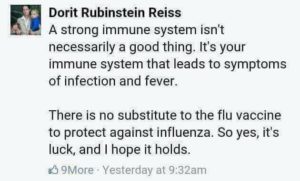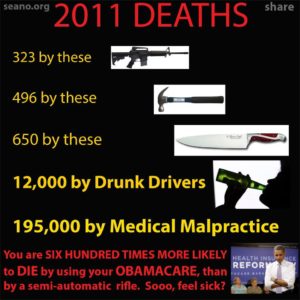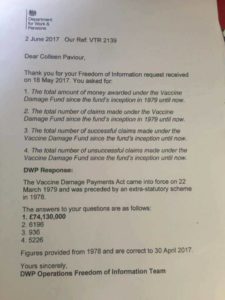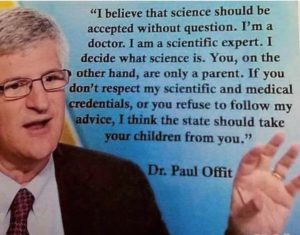Lawful Rebellion
UK Vaccine Damage Claims
This Guy Is A Tyrant, Not An Authority
Thimerasol Lie Countered
Sorry. I was wrong.
If you are pro-vaccine I owe you an apology.
I’ve been saying for sometime now that there are no long term double blind placebo based studies on vaccine safety.
I’ve been saying that no studies have compared the long term health of vaccinated children to the long term health of unvaccinated children.
The one thing pro-vaccine and anti-vaccine people agree on, is that this type of study would settle the debate once and for all and it’s really frustrating that the CDC refuse to conduct such a study.
Well I was wrong.
There is an ongoing study in Germany that compares the long term health of 17,641 vaccinated children with that of 15,320 unvaccinated children.
The study shows that vaccinated children are:
Twice as likely to have allergies
7 times more likely to have asthma/chronic bronchitis
3 and half times more likely to have hayfever
3.8 times more likely to have Hyperactivity
19 times more likely to have an Autoimmune disorder
10 times as likely to have Skoliosis
11 times as likely to have Epilepsy/Seizures
Twice as likely to have Migranes
And…oh yes…two and a half times more likely to have Autism.
Here’s a link to the study http://www.vaccineinjury.info/…/resu…/results-illnesses.html
Finally we have definitive, undeniable proof that the pharmaceutical propaganda of “vaccines are safe” that we’ve had to listen to spewing forth from the mouths of doctors and journalists and politicians for decades, is categorically and unequivocally false.
Please share this post with ever parent of a new born or infant child that you know. There is nothing more loving that you can do for them.
Finally we have something that can bring anti-vaccine and pro-vaccine people together, united against our common enemy.
The real clear and present danger to our children.
The Pharmaceutical Industry.
The world’s most profitable business, the one that got so rich and powerful by peddling the lies and propaganda that turned our kids into human ATM machines..
If you are pro-vaccine and you are wondering how you could have been so mislead and so misinformed that you got it completely backwards, here’s how…
“The combined profits for the ten drug companies in the Fortune 500 ($35.9 billion) were more than the profits for all the other 490 businesses put together ($33.7 billion) [in 2002]…
“…Similar conflicts of interest and biases exist in virtually every field of medicine, particularly those that rely heavily on drugs or devices. It is simply no longer possible to believe much of the clinical research that is published, or to rely on the judgment of trusted physicians or authoritative medical guidelines. I take no pleasure in this conclusion, which I reached slowly and reluctantly over my two decades as an editor of The New England Journal of Medicine.”
Marcia Angell – Author of
The Truth About the Drug Companies: How They Deceive Us and What to Do About It.
– Ellie Morphett
http://www.vaccineinjury.info/survey/comparison-of-the-state-of-health-of-unvaccinated-and-vaccinated-children.html
Did Monsanto Ignore Evidence Linking Its Weed Killer to Cancer?
Monanto has a Big Tobacco moment?
https://www.thenation.com/article/did-monsanto-ignore-evidence-linking-its-weed-killer-to-cancer/
Immune Boosting Recipes

Boosting your immune system naturally is good medicine!
http://www.foodmatters.com/recipe/immune-boosting-recipes
Immune System False Data

False data abounds.
Some of it from ignorance.
Some of it concocted as a defense to opinions not otherwise defensible.
Much of it from malicious intent to deceive.
Ignorance is not bliss.
It is deadly.
It pays to be informed.
The better informed you are, the better your chances for survival.
And, when you speak the truth, prepare to be attacked.
Do not take the attacks personally.
In fact, for the most part you can ignore them.
Responding to the attacker only gives them power.
Because truth is the more powerful line.
So do not empower their lies with your truth.
Keep speaking your truth.
Attackers of truth have the power only to enturbulate and upset you.
Only if you let them.
So do not let them.
Your dedicated and gentle persistence and continued communication proves their attacks failed and confirms your unkillability.
You will not reach all to whom you communicate so do not take losses on your failure to impinge.
After all, for a communication to be received, someone must be willing to be communicated to.
Some are so steeped in lies they cannot confront the truth.
Let not that deter you from your mission.
There are many who are willing to receive your message and have not yet heard it.
Science Got It Wrong
Shared from a friend on Facebook…
As the vaccine worshippers keep claiming “science says so” and proceed to try and shut down or discredit people by throwing around phrases like “I believe Science over Google” (a search engine to access the world’s largest library by the way) I thought this would interest them. Below is a list of drugs firstly approved due to “Science” stating they were safe and then later withdrawn because they were hurting so many people and in some cases killing them, they had no choice because they were held accountable. The “science” was actually wrong!! The cost of doing business is the old saying. But of course all the vaccines are perfectly safe because “Science” says so!
Alatrofloxacin 2006 Worldwide Liver toxicity; serious liver injury leading to liver transplant; death.
Alclofenac 1979 UK Vasculitis, Rash.
Alpidem (Ananxyl) 1995 Worldwide Not approved in the US, withdrawn in France in 1994 and the rest of the market in 1995 because of rare but serious hepatotoxicity.
Alosetron (Lotronex) 2000 US Serious gastrointestinal adverse events; ischemic colitis; severe constipation. Reintroduced 2002 on a restricted basis
Althesin (=Alphaxolone amineptine + Alphadolone) 1984 France, Germany, UK Anaphylaxis.
Amineptine (Survector) 1999 France, US Hepatotoxicity, dermatological side effects, and abuse potential. Reason:
Aminopyrine 1999 France, Thailand risk of agranulocytosis; severe acne.
Amobarbital 1980 Norway Self poisoning.
Amoproxan 1970 France Dermatologic and ophthalmic toxicity.
Anagestone acetate 1969 Germany Animal carcinogenicity.
Antrafenine 1984 France Unspecific experimental toxicity.
Aprotinin (Trasylol) 2008 US Increased risk of death.
Ardeparin (Normiflo) 2001 US Not for reasons of safety or efficacy.
Astemizole (Hismanal) 1999 US, Malaysia, Multiple Nonspecified Markets Fatal arrhythmia
Azaribine 1976 US Thromboembolism.
Bendazac 1993 Spain Hepatotoxicity.
Benoxaprofen 1982 Germany, Spain, UK, US Liver and kidney failure; gastrointestinal bleeding; ulcers.
Benzarone 1992 Germany Hepatitis.
Benziodarone 1964 France, UK Jaundice.
Beta-ethoxy-lacetanilanide 1986 Germany Renal toxicity, animal carcinogenicity.
Bezitramide 2004 Netherlands Fatal overdose.
Bithionol 1967 US Dermatologic toxicity.
Broazolam 1989 UK Animal carcinogenicity.
Bromfenac 1998 US Severe hepatitis and liver failure (some requiring transplantation).
Bucetin 1986 Germany Renal toxicity.
Buformin 1978 Germany Metabolic toxicity.
Bunamiodyl 1963 Canada, UK, US Nephropathy.
Butamben (Efocaine)(Butoforme) 1964 US Dermatologic toxicity; psychiatric Reactions.
Canrenone 1986 Germany Animal Carcinogenicity.
Cerivastatin (Baycol, Lipobay) 2001 US Risk of rhabdomyolysis
Chlormadinone (Chlormenadione) 1970 UK, US Animal Carcinogenicity.
Chlormezanone (Trancopal) 1996 European Union, US, South Africa, Japan Hepatotoxicity; Steven-Johnson Syndrome; Toxic Epidermal Necrolysis.
Chlorphentermine 1969 Germany Cardiovascular Toxicity.
Cianidanol 1985 France, Germany, Spain, Sweden Hemolytic Anemia.
Cinepazide 1988 Spain Agranulocytosis.
Cisapride (Propulsid) 2000 US Risk of fatal cardiac arrhythmias
Clioquinol 1973 France, Germany, UK, US Neurotoxicity.
Clobutinol 2007 Germany Ventricular arrhythmia, QT-prolongation.
Cloforex 1969 Germany Cardiovascular toxicity.
Clomacron 1982 UK Hepatotoxicity.
Clometacin 1987 France Hepatotoxicity.
Co-proxamol (Distalgesic) 2004 UK Overdose dangers.
Cyclobarbital 1980 Norway Self poisoning.
Cyclofenil 1987 France Hepatotoxicity.
Dantron 1963 Canada, UK, US Genotoxicity. withdrawn from general use in UK but permitted in terminal patients
Dexfenfluramine 1997 European Union, UK, US Cardiac valvular disease.
Propoxyphene (Darvocet/Darvon) 2010 Worldwide Increased risk of heart attacks and stroke.
Diacetoxydiphenolisatin 1971 Australia Hepatotoxicity.
Diethylstilbestrol 1970s Risk of teratogenicity
Difemerine 1986 Germany Multi-Organ toxicities.
Dihydrostreptomycin 1970 US Neuropsychiatric reaction.
Dilevalol 1990 UK Hepatotoxicity.
Dimazole (Diamthazole) 1972 France, US Neuropsychiatric reaction.
Dimethylamylamine (DMAA) 1983 US Voluntarily withdrawn from market by Lily.: Reintroduced as a dietary supplement in 2006; and in 2013 the FDA started work to ban it due to cardiovascular problems
Dinoprostone 1990 UK Uterine hypotonus, fetal distress.
Dipyrone(Metamizole) 1975 UK, US, Others Agranulocytosis, anaphylactic reactions.
Dithiazanine iodide 1964 France, US Cardiovascular and metabolic reaction.
Dofetilide 2004 Germany Drug interactions, prolonged QT.
Drotrecogin alfa (Xigris) 2011 Worldwide Lack of efficacy as shown by PROWESS-SHOCK study
Ebrotidine 1998 Spain Hepatotoxicity.
Efalizumab (Raptiva) 2009 Germany Withdrawn because of increased risk of progressive multifocal leukoencephalopathy
Encainide 1991 UK, US Ventricular arrhythmias.
Ethyl carbamate 1963 Canada, UK, US, Carcinogenicity.
Etretinate 1989 France Withdrawn US (1999). Risk for birth defects.
Exifone 1989 France Hepatotoxicity.
Fen-phen (popular combination of fenfluramine and phentermine) 1997 Cardiotoxicity
Fenclofenac 1984 UK Cutaneous reactions; animal carcinogenicity.
Fenclozic acid 1970 UK, US Jaundice, elevated hepatic enzymes.
Fenfluramine 1997 European Union, UK, US, India, South Africa, others Cardiac valvular disease, pulmonary hypertension, cardiac fibrosis.
Fenoterol 1990 New Zealand Asthma mortality.
Feprazone 1984 Germany, UK Cutaneous reaction, multiorgan toxicity.
Fipexide 1991 France Hepatotoxicity.
Flosequinan (Manoplax) 1993 UK, US Increased mortality at higher doses; increased hospitalizations.
Flunitrazepam 1991 France Abuse.
Gatifloxacin 2006 US Increased risk of dysglycemia.
Gemtuzumab ozogamicin (Mylotarg) 2010 US No improvement in clinical benefit; risk for death.
Glafenine 1984 France, Germany Anaphylaxis.
Grepafloxacin (Raxar) 1999 Withdrawn Germany, UK, US others Cardiac repolarization; QT interval prolongation.
Hydromorphone (Palladone, extended release version) 2005 High risk of accidental overdose when extended release version (Palladone) administered with alcohol. Standard hydromorphone is sold in most of the world including the US
Ibufenac 1968 UK Hepatotoxicity, jaundice.
Indalpine 1985 France Agranulocytosis.
Indoprofen 1983 Germany, Spain, UK Animal carcinogenicity, gastrointestinal toxicity.
Iodinated casein strophantin 1964 US Metabolic reaction.
Iproniazid 1964 Canada Interactions with food products containing tyrosine.
Isaxonine phosphate 1984 France Hepatotoxicity.
Isoxicam 1983 France, Germany, Spain, others Stevens johnson syndrome.
Kava Kava 2002 Germany Hepatotoxicity.
Ketorolac 1993 France, Germany, others Hemorrhage, renal Failure.
L-tryptophan 1989 Germany, UK Eosinophilic myalgia syndrome.Still sold in the US
Levamisole (Ergamisol) 1999 US Still used as veterinary drug and as a human antihelminthic in many markets; listed on the WHO List of Essential Medicines. In humans, it was used to treat melanoma before it was withdrawn for agranulocytosis.
Levomethadyl acetate 2003 US Cardiac arrhythmias and cardiac arrest.
Lumiracoxib (Prexige) 2007–2008 Worldwide Liver damage
Lysergic acid diethylamide (LSD) 1950s–1960s Marketed as a psychiatric drug; withdrawn after it became widely used recreationally. Now illegal in most of the world.
Mebanazine 1975 UK Hepatotoxicity, drug intereaction.
Methandrostenolone 1982 France, Germany, UK, US, others Off-label abuse.
Methapyrilene 1979 Germany, UK, US Animal carcinogenicity.
Methaqualone 1984 South Africa (1971), India (1984), United Nations (1971-1988) Withdrawn because of risk of addiction and overdose
Metipranolol 1990 UK, others Uveitis.
Metofoline 1965 US Unspecific experimental toxicity.
Mibefradil 1998 European Union, Malaysia, US, others Fatal arrhythmia, drug interactions.
Minaprine 1996 France Convulsions.
Moxisylyte 1993 France Necrotic hepatitis.
Muzolimine 1987 France, Germany, European Union Polyneuropathy.
Natalizumab (Tysabri) 2005–2006 US Voluntarily withdrawn from US market because of risk of Progressive multifocal leukoencephalopathy (PML). Returned to market July, 2006.
Nefazodone 2007 US, Canada, others Branded version withdrawn by originator in several countries in 2007 for hepatotoxicity. Generic versions available.
Nialamide 1974 UK, US Hepatotoxicity, drug intereaction.
Nikethamide 1988 multiple markets CNS Stimulation.
Nitrefazole 1984 Germany Hepatic and hematologic toxicity.
Nomifensine 1981-1986 France, Germany, Spain, UK, US, others Hemolytic Anemia, hepatotoxicity, serious hypersensitive reactions.
Oxeladin 1976 Canada, UK, US (1976) Carcinogenicity.
Oxyphenbutazone 1984-1985 UK, US, Germany, France, Canada Bone marrow suppression, Steven Johnson Syndrome.
Oxyphenisatin (Phenisatin) Australia, France, Germany, UK, US Hepatotoxicity.
Ozogamicin 2010 US No improvement in clinical benefit; risk for death; veno-occlusive disease.
Pemoline (Cylert) 1997 Canada, UK Withdrawn from US in 2005. Hepatotoxicity Reason:hepatotoxicity.
Pentobarbital 1980 Norway Self poisoning.
Pentylenetetrazol 1982 Withdrawn for inability to produce effective convulsive therapy, and for causing seizures.
Pergolide (Permax) 2007 US Risk for heart valve damage.
Perhexilene 1985 UK, Spain Neurologic and hepatic toxicity.
Phenacetin 1975 Canada An ingredient in “A.P.C.” tablet; withdrawn because of risk of cancer and kidney disease Germany Denmark, UK, US, others Reason: nephropathy.
Phenformin and Buformin 1977 France, Germany US Severe lactic acidosis[3]
Phenolphthalein 1997 US Carcinogenicity.
Phenoxypropazine 1966 UK Hepatotoxicity, drug intereaction.
Phenylbutazone 1985 Germany Off-label abuse, hematologic toxicity.
Phenylpropanolamine(Propagest, Dexatrim) 2000 Canada, US Hemorrhagic stroke.
Pifoxime (=Pixifenide) 1976 France Neuropsychiatric reaction.
Pirprofen 1990 France, Germany, Spain Liver toxicity.:223
Prenylamine 1988 Canada, France, Germany, UK, US, others Cardiac arrythmia and death.
Proglumide 1989 Germany Respiratory reaction.
Pronethalol 1965 UK Animal carcinogenicity.
Propanidid 1983 UK Allergy.
Proxibarbal 1998 Spain, France, Italy, Portugal, Turkey Immunoallergic, thrombocytopenia.
Pyrovalerone 1979 France Abuse.
Rapacuronium (Raplon) 2001 US, multiple markets Withdrawn in many countries because of risk of fatal bronchospasm
Remoxipride 1993 UK, others Aplastic anemia.
Rimonabant (Acomplia) 2008 Worldwide Risk of severe depression and suicide
Rofecoxib (Vioxx) 2004 Worldwide withdrawn by MAH. Risk of myocardial infarction and stroke
Rosiglitazone (Avandia) 2010 Europe Risk of heart attacks and death. This drug continues to be available in the US
Secobarbital France, Norway, others. Self poisoning.
Sertindole 1998 European Union Arrhythmia and sudden cardiac death
Sibutramine (Reductil/Meridia) 2010 Australia, Canada,China, the European Union (EU), Hong Kong, India, Mexico, New Zealand, the Philippines, Thailand, the United Kingdom,and the United States Increased risk of heart attack and stroke.
Sitaxentan 2010 Germany Hepatotoxicity.
Sorivudine 1993 Japan Drug interaction and deaths.
Sparfloxacin 2001 US QT prolongation and phototoxicity.
Sulfacarbamide 1988 Germany Dermatologic, hematologic and hepatic reactions.
Sulfamethoxydiazine 1988 Germany Unknown.
Sulfamethoxypyridazine 1986 UK Dermatologic and hematologic reactions
Suloctidyl 1985 Germany, France, Spain Hepatotoxicity.
Suprofen 1986-1987 UK, Spain, US Flank pain, decreased kidney function.
Tegaserod (Zelnorm) 2007 US Risk for heart attack, stroke, and unstable angina. Was available through a restricted access program until April 2008.
Temafloxacin 1992 Germany, UK, US, others Low blood sugar; hemolytic anemia; kidney, liver dysfunction; allergic reactions
Temafloxacin 1992 US Allergic reactions and cases of hemolytic anemia, leading to three patient deaths.
Temazepam (Restoril, Euhypnos, Normison, Remestan, Tenox, Norkotral) 1999 Sweden, Norway Diversion, abuse, and a relatively high rate of overdose deaths in comparison to other drugs of its group. This drug continues to be available in most of the world including the US, but under strict controls.
Terfenadine (Seldane, Triludan) 1997-1998 France, South Africa, Oman, others, US Prolonged QT interval; ventricular tachycardia
Terodiline (Micturin) 1991 Germany, UK, Spain, others Prolonged QT interval, ventricular tachycardia and arrhythmia.
Tetrazepam 2013 European Union Serious cutaneous reactions
Thalidomide 1961 Germany Withdrawn because of risk of teratogenicity; returned to market for use in leprosy and multiple myeloma under FDA orphan drug rules
Thenalidine 1960 Canada, UK, US Neutropenia
Thiobutabarbitone 1993 Germany Renal insufficiency.
Thioridazine (Melleril) 2005 Germany, UK Withdrawn worldwide due to severe cardiac arrhythmias
Ticrynafen(Tienilic acid) 1980 Germany, France, UK, US others Liver toxicity and death.
Tolcapone (Tasmar) 1998 European Union, Canada, Australia Hepatotoxicity
Tolrestat (Alredase) 1996 Argentina, Canada, Italy, others Severe hepatotoxicity
Triacetyldiphenolisatin 1971 Australia Hepatotoxicity.
Triazolam 1991 France, Netherlands, Finland, Argentina, UK others Psychiatric adverse drug reactions, amnesia.
Triparanol 1962 France, US Cataracts, alopecia, ichthyosis.
Troglitazone (Rezulin) 2000 US, Germany Hepatotoxicity
Trovafloxacin (Trovan) 1999-2001 European Union, US Withdrawn because of risk of liver failure
Valdecoxib (Bextra) 2004 US Risk of heart attack and stroke.
Vincamine 1987 Germany Hematologic toxicity.
Xenazoic acid 1965 France Hepatotoxicity.
Ximelagatran (Exanta) 2006 Germany Hepatotoxicity
Zimelidine 1983 Worldwide Risk of Guillain–Barré syndrome, hypersensitivity reaction, hepatotoxicity] banned worldwide.
Zomepirac 1983 UK, Germany, Spain, US Anaphylactic reactions and non-fatal allergic reactions, renal failure
Risks of Death From Pertussis (Whooping Cough) Versus the Vaccine
If you are considering vaccinating against pertussus, know the risks.
https://www.facebook.com/karibundyhealthactivist/videos/894131774054087/




